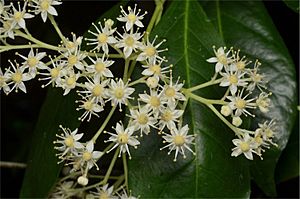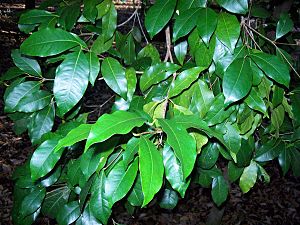Three-leaved bosistoa facts for kids
Quick facts for kids Three-leaved bosistoa |
|
|---|---|
 |
|
| Conservation status | |
| Scientific classification | |
| Genus: |
Bosistoa
|
| Species: |
transversa
|
| Synonyms | |
|
|

The Yellow Satinheart (scientific name: Bosistoa transversa) is a special kind of tree found only in eastern Australia. It's also called the Three-leaved Bosistoa because its leaves usually have three smaller parts, like fingers on a hand. This tree is usually small to medium-sized and grows in rainforests. It has small white flowers that grow in bunches.
Contents
What Does the Yellow Satinheart Look Like?
The Yellow Satinheart tree usually grows to be about 15 to 22 meters (about 50 to 72 feet) tall. Its trunk is often straight, but sometimes it can be a bit crooked. The trunk is about 8 to 20 centimeters (3 to 8 inches) wide. It has mostly smooth, dark brown bark with bumpy lines going across it.
Leaves and Branches
The leaves grow in pairs on thin brown or grey-brown branches. Each leaf is made up of smaller parts called leaflets. Most leaves have three shiny leaflets, but some can have up to seven. These leaflets have tiny oil glands that you can see. The whole leaf, including its stem (called a petiole), is about 85 to 160 millimeters (3.3 to 6.3 inches) long. The leaflets themselves are shaped like ovals, about 40 to 125 millimeters (1.6 to 4.9 inches) long and 10 to 60 millimeters (0.4 to 2.4 inches) wide.
Flowers and Fruit
Small white flowers appear from January to March. They grow in bunches called panicles, which are about 70 to 160 millimeters (2.8 to 6.3 inches) long. These flower bunches grow at the ends of branches or where leaves meet the stem. Each flower has five tiny green parts called sepals (about 1 millimeter long) and five white, oval-shaped petals (about 3 millimeters long).
After the flowers bloom (from December to May), small, woody, oval-shaped fruits appear. These fruits are called follicles and they usually grow in pairs. They ripen from May to July.
How the Yellow Satinheart Got Its Name
The Yellow Satinheart was first officially described in 1917 by two scientists from Queensland, Australia: John Frederick Bailey and Cyril Tenison White. They published their description in a science bulletin.
Meaning of the Names
- The first part of its scientific name, Bosistoa, honors a person named Joseph Bosisto. He was a person who made essential oils.
- The second part, transversa, means "across" or "transverse." This name was chosen because the fruit of the tree has ridges that go across it.
Where Does the Yellow Satinheart Grow?
The Yellow Satinheart tree grows in eastern Australia. You can find it from a place called Mount Larcom in central-eastern Queensland, all the way south to Mullumbimby in north-eastern New South Wales. It likes to grow in forests and subtropical rainforests. It can be found from sea level up to about 500 meters (about 1,640 feet) high.
Is the Yellow Satinheart in Danger?
Yes, the Yellow Satinheart is considered a vulnerable species. This means it's at risk of becoming endangered if we don't protect it. Both the Australian Government and the government of New South Wales have laws to protect it.
Main Threats
The biggest problems for the Yellow Satinheart tree are:
- Clearing rainforests: People cutting down the rainforests where it lives.
- Weeds: Other plants (weeds) growing into the rainforest areas and taking over.
- Grazing by livestock: Farm animals eating the young trees or damaging their habitat.


